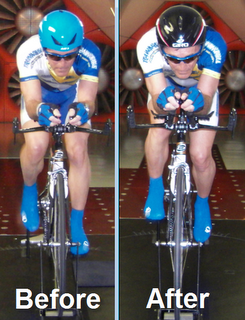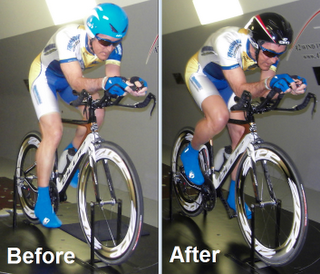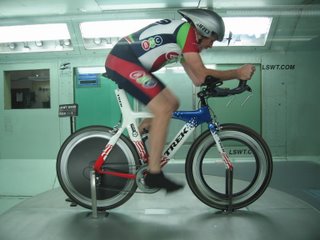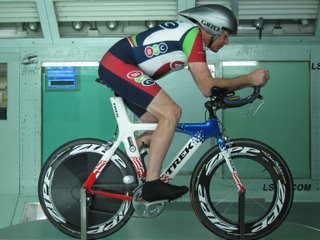My Bike Fit and Wind Tunnel Testing
I spent the morning in the A2 Wind Tunnel in Mooresville, North Carolina doing one-minute intervals into a 30-mph headwind to get my new Blue Triad SL dialed in for this next season’s racing. While I had taken clients to wind tunnels before, this my first opportunity to get my own time trial bike and position tested.
I’ve had many bike fits done and highly recommend that as a necessity regardless of whether or not your next step will be a wind tunnel. A bike fit will cost you from $100 to $300 depending on how much time it takes and the reputation of the fitter. I found the A2 tunnel to be rather inexpensive as wind tunnels go. I’m used to having my clients pay up to $800 per hour. A2 charges _only_ $390 for an hour. I spent the better part of two hours on the saddle in the tunnel. And that’s about how much time my clients have also needed. That’s still a fair chunk of change so you want to come away with positive results. “Buying” a minute for a 40k is very expensive.
Again, I recommend that everyone has a bike fit done by a professional fitter. I go to a lot of races and see horrible bike positions that reduce power and increase drag – the worst possible combination. With a few small adjustments I could do wonders for nearly all of these riders (the others need bikes that fit – you can’t do much to correct that). It would take hours of weekly training for several months to build more power in order to reap the same benefit as a few basic adjustments of the bike set up would take.
So here’s what led me to Mooresville… After the new Blue TT bike was built up I met with Chris Pulleyn at Bicycle Ranch in Scottsdale, Arizona for a fit. Chris has done this for every athlete I’ve coached for the past three years. He is meticulous and determined to get an excellent position. Accompanying is a picture of Chris setting the position right at the end of the fit. I liked the position we came up with and felt both powerful and aerodynamic.

The before-after pictures you see here show fairly well the changes that Mike Giraud at A2 made in my position. He started by lowering the handlebars. This was done four times for a total drop of 4.5cm. Each time I became a bit more aero, but power dropped off a bit also. By the fourth time the trade off wasn’t good and so he brought the bars back up 5mm. Then he began bringing the elbows in, about 3cm at a time for three tries. The last was too much and so I ended up with the elbow pads 3cm narrower than when we started. This made for a bit too much discomfort in trying t hold on to the S-bend aerobars and so he rotate them I so that the bar ends nearly touched.
After a try at making my shoulders narrower by lifting them toward my ears, which didn’t achieve very much, he tried a different helmet. My Garneau Rocket Air helmet (blue in pictures) was replaced by a Giro Advantage 2 (black in pictures). The Giro helmet fit a bit closer to my back and also seemed better shaped for my head. I also liked the heavily padded ear covers, which quieted the 30mph wind. (Interestingly, this latter is suggested by John Cobb to reduce the sound of the air thus reducing one’s perceived exertion. Only he achieves it by using ear plugs.)
The bottom line is that I wound up with my bars 4cm lower, my elbows 3cm narrower, my hands brought together by rotating the bar extensions, and different helmet. The power and drag numbers are not available as I write this. I will post them at another time.
I’m now ready to race – except for the fitness part.
Labels: bike fit, wind tunnel



